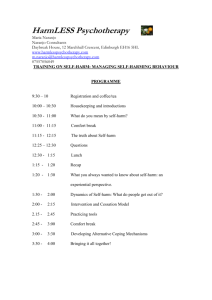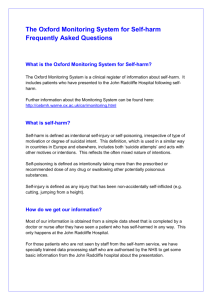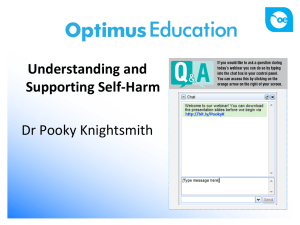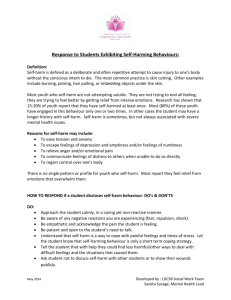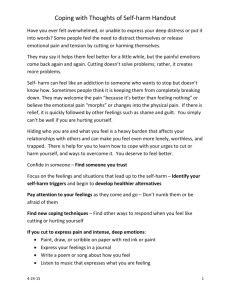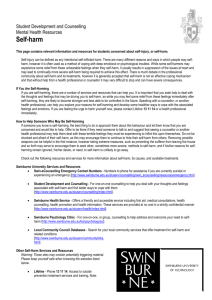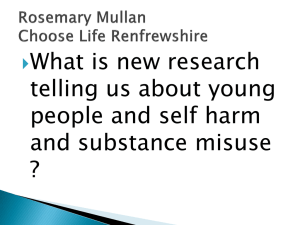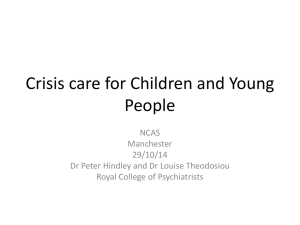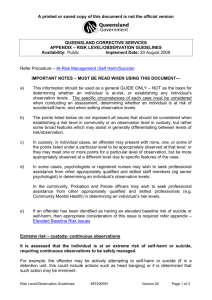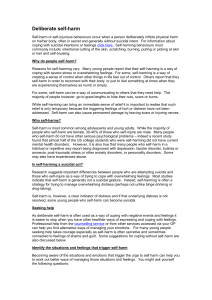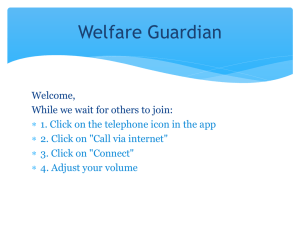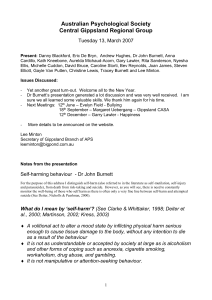Understanding Self-Injury or Self-Harm
advertisement
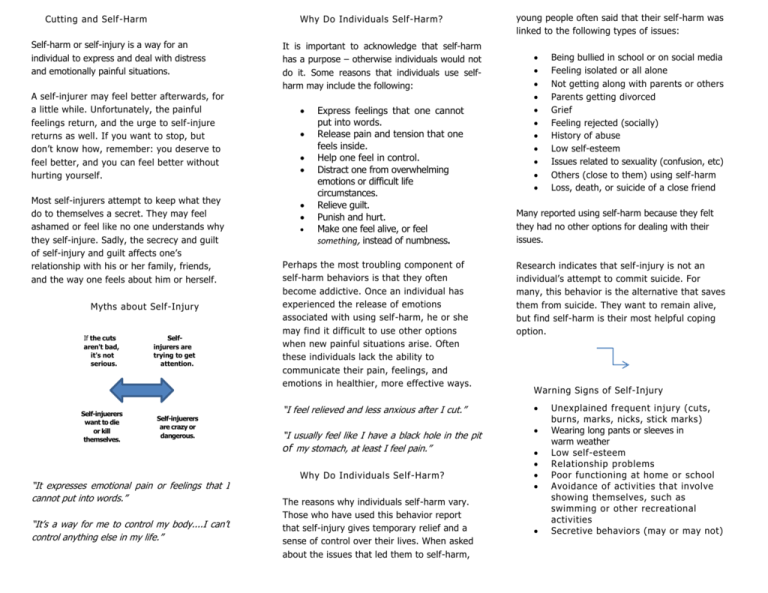
Why Do Individuals Self-Harm? Cutting and Self-Harm Self-harm or self-injury is a way for an individual to express and deal with distress and emotionally painful situations. A self-injurer may feel better afterwards, for a little while. Unfortunately, the painful feelings return, and the urge to self-injure returns as well. If you want to stop, but don’t know how, remember: you deserve to feel better, and you can feel better without hurting yourself. Most self-injurers attempt to keep what they do to themselves a secret. They may feel ashamed or feel like no one understands why they self-injure. Sadly, the secrecy and guilt of self-injury and guilt affects one’s relationship with his or her family, friends, and the way one feels about him or herself. Myths about Self-Injury If the cuts aren't bad, it's not serious. Self-injuerers want to die or kill themselves. Selfinjurers are trying to get attention. Self-injuerers are crazy or dangerous. “It expresses emotional pain or feelings that I cannot put into words.” “It’s a way for me to control my body....I can’t control anything else in my life.” It is important to acknowledge that self-harm has a purpose – otherwise individuals would not do it. Some reasons that individuals use selfharm may include the following: Express feelings that one cannot put into words. Release pain and tension that one feels inside. Help one feel in control. Distract one from overwhelming emotions or difficult life circumstances. Relieve guilt. Punish and hurt. Make one feel alive, or feel something, instead of numbness. Perhaps the most troubling component of self-harm behaviors is that they often become addictive. Once an individual has experienced the release of emotions associated with using self-harm, he or she may find it difficult to use other options when new painful situations arise. Often these individuals lack the ability to communicate their pain, feelings, and emotions in healthier, more effective ways. young people often said that their self-harm was linked to the following types of issues: Many reported using self-harm because they felt they had no other options for dealing with their issues. Research indicates that self-injury is not an individual’s attempt to commit suicide. For many, this behavior is the alternative that saves them from suicide. They want to remain alive, but find self-harm is their most helpful coping option. Warning Signs of Self-Injury “I feel relieved and less anxious after I cut.” “I usually feel like I have a black hole in the pit of my stomach, at least I feel pain.” Why Do Individuals Self-Harm? The reasons why individuals self-harm vary. Those who have used this behavior report that self-injury gives temporary relief and a sense of control over their lives. When asked about the issues that led them to self-harm, Being bullied in school or on social media Feeling isolated or all alone Not getting along with parents or others Parents getting divorced Grief Feeling rejected (socially) History of abuse Low self-esteem Issues related to sexuality (confusion, etc) Others (close to them) using self-harm Loss, death, or suicide of a close friend Unexplained frequent injury (cuts, burns, marks, nicks, stick marks) Wearing long pants or sleeves in warm weather Low self-esteem Relationship problems Poor functioning at home or school Avoidance of activities that involve showing themselves, such as swimming or other recreational activities Secretive behaviors (may or may not) “Self-harm and cutting don’t help with the issues that made one want to hurt him/herself in the first place.” Need help for Self-Harm? Call the S.A.F.E. Alternatives information line in the U.S. at (800)366-8288 for more information. Tips for Talking about Self-Harm In the middle of a crisis? Need help now? National Suicide Prevention Lifeline: (800)273-8255 Focus on your feelings: talk about the situation that led to the self-injury. This will help the listener understand where you are coming from. Communicate in a way that makes you the most comfortable. Don’t feel pressured to talk about issues you are not ready to discuss but begin to get in touch with your feelings. Understand that support people need time to process what you tell them. You may not like the way they react, but realize they are reacting because they care about you. The more individuals understand self-harm, the better they can support you. Talking about self-harm can be very emotionally overwhelming. Changing longstanding habits takes strength and courage, but you will start to feel better as you work through the emotions and issues involved. Local Resources: Information and Resources for Parents GCHS School Counselors: Arts & Comm: Kristina Younkman 620 805-5419 Freshman Academy: Christy Schaefer 620 805-5448 Health: Jennifer Meng 620 805-5427 Public Service: Sheri Smith 620 805-5439 Trade: KaeLee Hogan 620 805-5426 Understanding SelfInjury or Self-Harm GCHS Nurses’ Office: 805-5415 Area Mental Health Center: 276-7689 Christian Counseling: 276-1500 EKM Family Center: 271-1811 Websites: Learn to manage overwhelming stress and emotions. National Mental Health Assoc. www.nmha. org National Institute of Mental Health: www.nhmi.org www.swlfharmuk.org Identify your self-harm triggers so that you can develop healthier options for handling stress. Books for parents: www.helpguide.org/mental/selfinjury.htm uses a 3 min. video titled Developing Emotional Awareness (check it out) Garden City High School 2720 Buffalo Way Levenkron, Steven. (1998) Cutting: Understanding and Overcoming Self-Mutilation. Lader, Wendy PhD. and Karen Conterio Bodily Harm Alderman, Tracy, PhD. The Scarred Soul Information in pamphlet was adapted from Lincoln Board of Education/Lincoln Public Sch and www.helpguide.org/mental/selfinjury.htm
